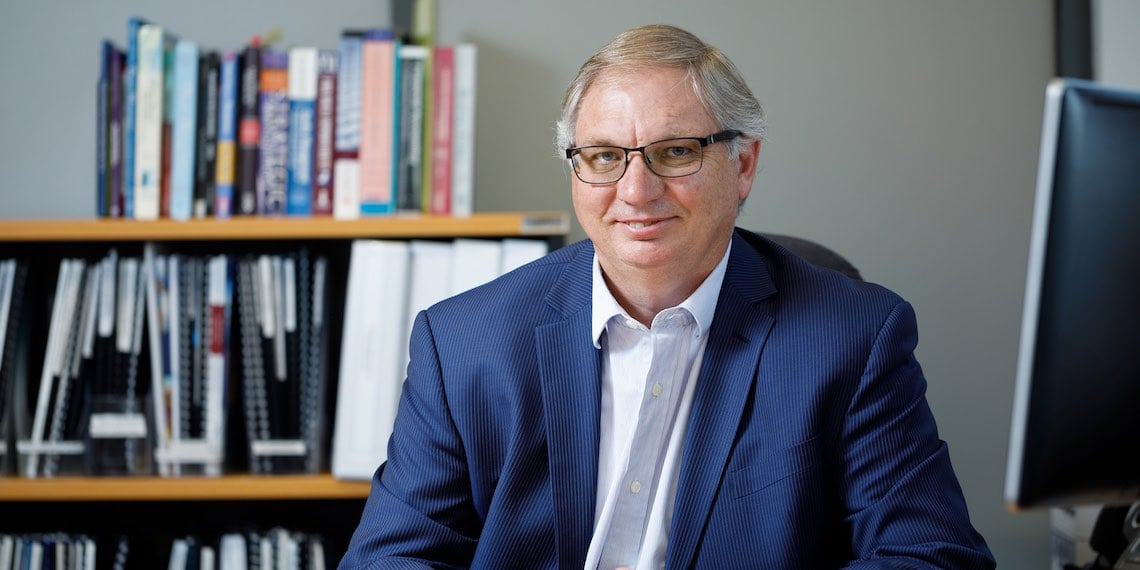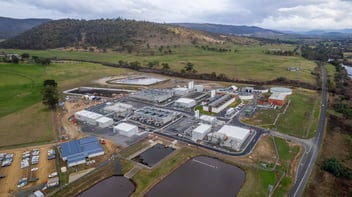TasWater prepares to farewell CEO after nine years of leadership

TasWater CEO Michael Brewster will step down in February 2022 following almost nine years of leadership that has guided the utility through an array of impressive transformations.
Appointed as TasWater CEO in 2013 when the utility first formed, following the largest economic reform undertaken in Tasmania, Brewster has led the organisation through the challenge of unifying a raft of disparate asset systems, pricing schemes and staffing arrangements.
Reflecting on the task, Brewster said the initial hurdle was to bring together a large staff base under the one banner and to ensure TasWater’s customers were kept front and centre.
“The first challenge was bringing together over 800 staff from four corporations and trying to mould them into one with a common set of values and vision,” he said.
“But we also had significant challenges around servicing our customers. There was an urgent need to improve water quality for our regional towns. We had lots of towns on public health alerts; they either had to boil their water or couldn't drink it.
“We also wanted to move towards the provision of consistent levels of service with an initial focus on delivering quality drinking water.”
Furthermore, the newly formed utility had inherited a large amount of assets and water treatment systems, and investment needs were high, Brewster said.
“Our infrastructure is dispersed right across the state. When we inherited the business, there were significant investment needs identified. This was made even more difficult due to the number of plants and assets that we inherited. That was a really big challenge,” he said.
“We had to determine how best to bring the most critical of these systems up to scratch in a reasonable timeframe, that was also affordable for our customers.
“We also wanted to bring all of our customers onto a single pricing model with no cross subsidies between customer groups, as we inherited a lot of cross-subsidies with different pricing regimes across regions. In essence we wanted to simplify pricing wherever possible and provide consistent pricing for the same levels of service across the state.”
Meeting the challenge
While the challenges were large and many, Brewster said TasWater has realised some huge achievements in the past few years, including the complete removal of boil-water alerts for the state's regional communities.
“We started with a focus on what our customers actually wanted. We had to engage closely with our customers, regulators and impacted communities to better align our investment priorities,” he said.
“When we first started, we had a high number of contamination incidents and boil-water alerts. We recorded over 30 E.coli incidents when we started, but last year we had only one and that was clear on a re-sample.
“Achieving 100% microbiological compliance over the last three years, considering where we started from at 94%, has been a very pleasing result.”
Since commencement, TAsWater has removed 35 boil-water alerts and do-not-consume notices, and 28 of those were removed over a three year period between 2017 and 2020 through the 24 Glasses Regional Towns Water Supply Program.
“This achievement was recently capped off with the drinking water produced from our Rossarden Water Treatment Plant winning world’s best tasting water. A far cry from customers not being able to drink the water prior to the construction of the new plant,” Brewster said.
“Our customer service centre satisfaction is currently sitting at 97% with customer complaints having halved in recent years. We have also transferred all of our residential customers onto a common statewide pricing scheme.”
Internally, Brewster said the utility has also made great gains in supporting staff and ensuring the development of leadership teams.
“We put a lot of effort into investing in future skills, in recent years we have set up internships, scholarships and a leadership program that has really made a difference. If you don't have the right people with the right skills, it’s very difficult to get traction. This has been a key to driving innovation and new ways of working,” he said.
“To date we have spent $1 billion fixing, upgrading and renewing infrastructure. The need to reliably deliver a growing capital program over the next few years has also been the catalyst for setting up a Capital Delivery Office leveraging the skills of our partners the CIMIC group.
“We’ve reached agreements with the state government and owner councils on the means of funding our program into the future that doesn’t unreasonably burden future generations of water customers.”
Passing on insight
With his time at TasWater drawing to a close, Brewster said he has learned a lot from the experience, including insights that might prove useful to other regional utilities seeking to improve service provision.
“It’s crucial to start by figuring out what customers really value. I had a few surprises, up front. We think we might know what our communities want, but clarifying those values and understanding them is absolutely critical,” he said.
“We certainly haven’t always got it right but try to build the lessons into future engagements. There is also a reality that you must accept, and that is that you won’t be able to reach agreement with everyone. What matters then is to keep to the facts, continue to listen carefully and treat everyone with respect; irrespective of their position or views.
“Quality data is also very important. It took me a little while to realise just how important quality data is for good decision making in the water industry.
“When embarking on large-scale transformations, there is always going to be significant uncertainty and judgement required, therefore having access to reliable information and solid analytical capability is essential if you are going to realise your goals.”
Brewster said it’s also important to work closely with councils and communities, bringing them along on the journey when changes are required.
“Understand that communities will often accept a rationale economic argument for not introducing services but if you are going to take a service or asset away from a community, that’s a different story,” he said.
“Regardless of how well the business case stacks up, it is extremely difficult to progress the removal of services when the community have experienced the benefit of that service for many years.”
Brewster said he also learned a lot from the trials of other water utilities, in Australia and abroad, which helped TasWater move more quickly through the transformation process.
Most things have been done before. Learning from people who have been there and done that saves enormous time and effort. There are so many experienced people in this industry, and the international water industry, who have tried pretty much everything,” he said.
“But successful change is also all about your people and your team. Unless you create a constructive and positive environment for your people, it’s impossible to achieve positive change. Leaders need to lead by example.”
TasWater’s future
Brewster said he’d like to see the utility’s focus remain squarely on its people and its customers.
“I fully expect that to continue,” he said.
“In terms of the capital program, there are about five or six years of large scale major capital investments lined up. But, whatever occurs, TasWater has always had a goal of keeping our prices mid-range or lower.
“This means regularly making tradeoffs and looking to ensure that water and sewerage prices remain affordable for customers by focusing on productivity improvement and accepting the need for tradeoffs. For this reason we have maintained a dedicated productivity team and set ourselves cost-reduction goals every year which are taken off the budget at the start of the year.
“The future challenge for the utility will be to continue to provide great quality water and sewage services, while still remaining mid-tier in regard to water and sewerage changes given the extraordinary number of assets under management and dispersion of those assets around the state.
“Also, recognising that governments are a partner; there is enormous strength that can be leveraged between a utility, state government and local government when everyone is working together towards a common cause. Continuing to nurture these relationships will see TasWater do very well into the future.”
Brewster said he didn’t expect to remain within the water sector for as long as he did, but that his time at TasWater has given him a deep appreciation for the industry and the people who work within it.
“Prior to joining TasWater, my focus was on large-scale transformation projects in the power sector. I didn’t come into the water sector with any particular water skills, but I saw the opportunity to do something exciting and different,” he said.
“What I have developed through this role is a love for the water industry. It gets under your skin, you get the chance to make a real difference to public health and people’s lives and work with many wonderful and passionate people.
“The water industry attracts a lot of people who are really dedicated to servicing their communities and making a difference. I found that this aspect of the industry makes it relatively easy to get people focused on a common vision and goal.
“Much of my enjoyment in this role has come from being able to share my experiences and ideas and watch others leverage it, and then take it to another level.”

